#Robert Wald
Photo

Der See von Albano und Schloss Gandolfo von John Robert Cozens (1779, Wasserfarbe auf Papier)
#kunst#kunstwerk#art#artwork#john robert cozens#künstler#artist#landschaft#landscape#natur#nature#grün#green#wald#forest#bäume#trees#pflanzen#plants#schloss#castle#gandolfo#schloss gandolfo#castle gandolfo#see#lake#see von albano#lake of albano#aussicht#blick
11 notes
·
View notes
Photo

Midsummer Eve by Edward Robert Hughes (watercolour heightened with gouache on paper)
#art#artwork#kunst#kunstwerk#Edward Robert Hughes#midsummer eve#mitsommerabend#night#nacht#atmospheric#atmosphäre#glowing#leuchten#mythical creatures#mystische figuren#mythical art#mystische kunst#dancing#tanzen#lantern#laternen#fairytale#märchen#wood#holz#forest#wald#victorian#fairies#feen
12 notes
·
View notes
Text
May 2024 Birthdays | Wednesday, 05.01.24
Here are the upcoming birthdays for these awesome voice talents in the month of May 2024 down below, including:
Wednesday, 5/1 (Today)
Frank Todaro
Thursday, 5/2 (Tomorrow)
Monét Lerner
Vincent Tong
Monday, May 6
Wally Wingert
Wednesday, 5/8
Abby Trott
Caitlynn French
Chuck Huber
Friday, 5/10
Rachel Robinson
Saturday, 5/11
Anastasia Munoz
David Wald
Tia Ballard
Sunday, 5/12
Robert Tinkler
Monday, 5/13
Kirk Thorton
Tuesday, 5/14
Alex Moore
Jessica Boone
Thursday, 5/16
Khary Payton
Monday, 5/20
Ray Chase
Saturday, 5/25
J. Michael Tatum
Tuesday, 5/28
Laura Bailey
Liam O'Brien
Townsend Coleman (70th birthday soon)
Wednesday, 5/29
Brandon Mychal Smith
Erica Lindbeck
Thursday, 5/30
Mikaela Krantz
#2024 birthdays#abby trott#brandon mychal smith#caitlynn french#chuck huber#david wald#erica lindbeck#frank todaro#j. michael tatum#jessica boone#kirk thornton#khary payton#laura bailey#liam o'brien#may#may 1st#may 2024#mikaeka krantz#monét lerner#ray chase#robert tinkler#tia ballard#townsend coleman#upcoming#upcoming birthdays#vincent tong#voice talents#wednesday wisdom
4 notes
·
View notes
Text

Ich empfehle heute:
#ich empfehle heute:#ava famehri#im düstern wald werden unsere Leiber hängen#die partei#soundcloud#fsk 93#graffiti#intellektualität#bukowski#bürgerlichkeit#kafka#konkret#gängeviertel#edition nautilus#humor#authentizität#dante alighieri#inferno#robert frost#rabindranath tagore
0 notes
Text
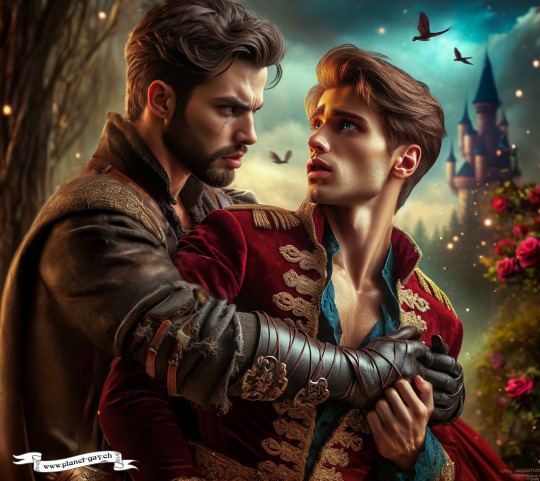
The Robber and the Prince
"A handsome young prince lost in the woods. Then robbers seized him, yet one of the robbers loved this prince. I love you my prince. I love you my robber. Dark and gold."
Original German text: "Ein schöner junger Prinz verirrte sich im Wald. Da packten ihn die Räuber, doch einer von den Räubern, liebte diesen Prinzen. Ich liebe dich mein Prinzen. Ich liebe dich mein Räuber. Dunkel und Gold"
These lines from the song "Der Räuber und der Prinz" by Deutsch Amerikanische Freundschaft (DAF) encapsulate more than just an unusual narrative. It is a poetic depiction of love and desire that challenges societal norms and expectations. Released in the early 80s, this song is emblematic of how DAF explored themes of sexuality, identity, and nonconformity in their music.
DAF, often regarded as pioneers of electronic music and the Neue Deutsche Welle, have left an indelible mark on music history. With their radical aesthetic, provocative lyrics, and minimalist synthesizer sounds, Gabi Delgado-López and Robert Görl represented an art form that consciously deviated from the commercial pop and rock music traditions of their time.
DAF's significance to the LGBT movement in the 80s cannot be overstated. At a time when LGBT rights were largely ignored or openly opposed, DAF offered a rare glimpse into queer love and desire. "Der Räuber und der Prinz" stands out for its story of unexpected and socially taboo love that defies conventional narratives.
The fact that one of the band members, Gabi Delgado-López, openly lived his bisexuality, lent DAF's music authenticity and a political dimension. Their songs were not just expressions of personal freedom and sexual liberation but also acts of resistance against the repressive social norms of the time.
DAF's influence extends beyond the boundaries of music. They helped increase the visibility of LGBT themes in the public sphere and initiated a dialogue on gender, sexuality, and identity that continues today. Their fearless commitment to individuality and nonconformity makes them icons of the LGBT movement and pioneers of a cultural revolution that began in the 80s and echoes in today's society.
"The Robber and the Prince" thus symbolizes not only DAF's artistic vision but also a moment of emancipation in the history of the LGBT movement. The song and the band itself remind us that love in all its forms should be celebrated and that music can be a powerful force for change and acceptance.
Text supported by Chat GPT-4
Base Image generated with DALL-E, overworked with SD-1.5 and SDXL inpainting and composing.
#DAF#TheRobberAndThePrince#LGBTQMusicHistory#ElectronicMusic#NeueDeutscheWelle#LGBTQRights#LoveIsLove#Pride#QueerIcons#Nonconformity#SexualLiberation#gayart#queer#LGBT#manlovesman
29 notes
·
View notes
Text
Robert Johnson
According to legend, as a young man living on a plantation in rural Mississippi, Johnson had a tremendous desire to become a great blues musician. One of the legends often told says that Johnson was instructed to take his guitar to a crossroad near Dockery Plantation at midnight. (There are claims for other sites as the location of the crossroads.) There he was met by a large black man (the Devil) who took the guitar and tuned it. The Devil played a few songs and then returned the guitar to Johnson, giving him mastery of the instrument. This story of a deal with the Devil at the crossroads mirrors the legend of Faust. In exchange for his soul, Johnson was able to create the blues for which he became famous.

This legend was developed over time and has been chronicled by Gayle Dean Wardlow, Edward Komara and Elijah Wald, who sees the legend as largely dating from Johnson's rediscovery by white fans more than two decades after his death. Son House once told the story to Pete Welding as an explanation of Johnson's astonishingly rapid mastery of the guitar. Other interviewers failed to elicit any confirmation from House and there were fully two years between House's observation of Johnson as first a novice and then a master.
Further details were absorbed from the imaginative retellings by Greil Marcus and Robert Palmer. Most significantly, the detail was added that Johnson received his gift from a large black man at a crossroads. There is dispute as to how and when the crossroads detail was attached to the Robert Johnson story. All the published evidence, including a full chapter on the subject in the biography Crossroads, by Tom Graves, suggests an origin in the story of the blues musician Tommy Johnson. This story was collected from his musical associate Ishman Bracey and his elder brother Ledell in the 1960s. One version of Ledell Johnson's account was published in David Evans's 1971 biography of Tommy Johnson, and was repeated in print in 1982 alongside House's story in the widely read Searching for Robert Johnson, by Peter Guralnick.
In another version, Ledell placed the meeting not at a crossroads but in a graveyard. This resembles the story told to Steve LaVere that Ike Zimmerman of Hazlehurst, Mississippi, learned to play the guitar at midnight while sitting on tombstones. Zimmerman is believed to have influenced the playing of the young Johnson.
Recent research by the blues scholar Bruce Conforth, in Living Blues magazine, makes the story clearer. Johnson and Ike Zimmerman did practice in a graveyard at night, because it was quiet and no one would disturb them, but it was not the Hazlehurst cemetery as had been believed: Zimmerman was not from Hazlehurst but nearby Beauregard, and he did not practice in one graveyard, but in several in the area. Johnson spent about a year living with and learning from Zimmerman, who ultimately accompanied Johnson back to the Delta to look after him.
While Dockery, Hazlehurst and Beauregard have each been claimed as the locations of the mythical crossroads, there are also tourist attractions claiming to be "The Crossroads" in both Clarksdale and Memphis. Residents of Rosedale, Mississippi, claim Johnson sold his soul to the devil at the intersection of Highways 1 and 8 in their town, while the 1986 movie Crossroads was filmed in Beulah, Mississippi. The blues historian Steve Cheseborough wrote that it may be impossible to discover the exact location of the mythical crossroads, because "Robert Johnson was a rambling guy".
Some scholars have argued that the devil in these songs may refer not only to the Christian figure of Satan but also to the trickster god of African origin, Legba, himself associated with crossroads. Folklorist Harry M. Hyatt wrote that, during his research in the South from 1935 to 1939, when African-Americans born in the 19th or early 20th century said they or anyone else had "sold their soul to the devil at the crossroads", they had a different meaning in mind. Hyatt claimed there was evidence indicating African religious retentions surrounding Legba and the making of a "deal" (not selling the soul in the same sense as in the Faustian tradition cited by Graves) with the so-called devil at the crossroads.
The Blues and the Blues singer has really special powers over women, especially. It is said that the Blues singer could possess women and have any woman they wanted. And so when Robert Johnson came back, having left his community as an apparently mediocre musician, with a clear genius in his guitar style and lyrics, people said he must have sold his soul to the devil. And that fits in with this old African association with the crossroads where you find wisdom: you go down to the crossroads to learn, and in his case to learn in a Faustian pact, with the devil. You sell your soul to become the greatest musician in history.
This view that the devil in Johnson's songs is derived from an African deity was disputed by the blues scholar David Evans in an essay published in 1999, "Demythologizing the Blues":
There are ... several serious problems with this crossroads myth. The devil imagery found in the blues is thoroughly familiar from western folklore, and nowhere do blues singers ever mention Legba or any other African deity in their songs or other lore. The actual African music connected with cults of Legba and similar trickster deities sounds nothing like the blues, but rather features polyrhythmic percussion and choral call-and-response singing.
The musicologist Alan Lomax dismissed the myth, stating, "In fact, every blues fiddler, banjo picker, harp blower, piano strummer and guitar framer was, in the opinion of both himself and his peers, a child of the Devil, a consequence of the black view of the European dance embrace as sinful in the extreme".
Both Lomax's and Evans's accounts themselves have been disputed and dismissed by Black scholars and authors including Amiri Baraka and Cornel West. West defines Blues as a creation of a people "who are willing to look unflinchingly at catastrophic conditions", as children of God responding to those conditions. Baraka's words are more directly critical of white writers who study African-American Blues artform and culture from a Western viewpoint, stating that they "They have to do that to make themselves superior in some kind of way: that everything has come from Europe, which is not true". Baraka cites that rather than being formed out of any Western context, Blues derives from an African context of its own. The call-and-response singing Lomax argues is different from Blues has been widely cited as being a central aspect of Blues music.
58 notes
·
View notes
Text
Why.te lady CONFRONTS her race & calls them out for ATROCITIES on Americ...
youtube
No human being on earth should tolerate the intolerable and Black Indigenous People globally need to stop being cowards and stand up for what is right and proper. This lady is so indoctrinated in whiteness that even though she knows race is a social construct because Dr. Robert Wald Sussman talked to her himself years before he died and so did Dr.Audrey Smedley.
#black love#black positivity#black africans#black history#science#evolution#science side of tumblr#Youtube
16 notes
·
View notes
Text

Immense pride, tinged with sadness.
For those who would like to read the full list:
1908 MECHNIKOV, ELIE
FOR THEIR WORK ON IMMUNITY
1908 EHRLICH, PAUL
FOR THEIR WORK ON IMMUNITY
1914 BARANY, ROBERT
FOR HIS WORK ON THE PHYSIOLOGY AND PATHOLOGY OF THE VESTIBULAR APPARATUS
1922 MEYERHOF, OTTO FRITZ
FOR HIS DISCOVERY OF THE FIXED RELATIONSHIP BETWEEN THE CONSUMPTION OF
OXYGEN AND THE METABOLISM OF LACTIC ACID IN THE MUSCLE
1930 LANDSTEINER, KARL
FOR HIS DISCOVERY OF HUMAN BLOOD GROUPS
1936 LOEWI, OTTO
FOR THEIR DISCOVERIES RELATING TO CHEMICAL TRANSMISSION OF NERVE IMPULSES
1944 ERLANGER, JOSEPH
FOR THEIR DISCOVERIES RELATING TO THE HIGHLY DIFFERENTIATED FUNCTIONS OF SINGLE NERVE FIBRES
1945 CHAIN, ERNST BORIS
FOR THE DISCOVERY OF PENICILLIN AND ITS CURATIVE EFFECT IN VARIOUS INFECTIOUS DISEASES
1946 MULLER, HERMANN J.
FOR THE DISCOVERY OF THE PRODUCTION OF MUTATIONS BY MEANS OF X-RAY IRRADIATION
1947 CORI, GERTY THERESA, RADNITZ
FOR THEIR DISCOVERY OF THE COURSE OF THE CATALYTIC CONVERSION OF GLYCOGEN
1950 REICHSTEIN, TADEUS
FOR THEIR DISCOVERIES RELATING TO THE HORMONES OF THE ADRENAL CORTEX, THEIR STRUCTURE AND BIOLOGICAL EFFECTS
1952 WAKSMAN, SELMAN A.
FOR HIS DISCOVERY OF STREPTOMYCIN, THE FIRST ANTIBIOTIC EFFECTIVE AGAINST TUBERCULOSIS
1953 LIPMANN, FRITZ ALBERT
FOR HIS DISCOVERY OF CO-ENZYME A AND ITS IMPORTANCE FOR INTERMEDIARY METABOLISM
1953 KREBS, HANS ADOLF
FOR HIS DISCOVERY OF THE CITRIC ACID CYCLE
1958 LEDERBERG, JOSHUA
FOR HIS DISCOVERIES CONCERNING GENETIC RECOMBINATION AND THE ORGANISATION OF THE GENETIC MATERIAL OF BACTERIA
1959 KORNBERG, ARTHUR
FOR THEIR DISCOVERY OF THE MECHANISMS IN THE BIOLOGICAL SYNTHESIS OF RIBONUCLEIC ACID AND DEOXYRIBONUCLEIC ACID
1964 BLOCH, KONRAD
FOR THEIR DISCOVERIES CONCERNING THE MECHANISM AND REGULATION OF THE CHOLESTEROL AND FATTY ACID METABOLISM
1965 JACOB, FRANCOIS
FOR THEIR DISCOVERIES CONCERNING GENETIC CONTROL OF ENZYME AND VIRUS SYNTHESIS
1965 LWOFF, ANDRE
FOR THEIR DISCOVERIES CONCERNING GENETIC CONTROL OF ENZYME AND VIRUS SYNTHESIS
1967 WALD, GEORGE
FOR THEIR DISCOVERIES CONCERNING THE PRIMARY PHYSIOLOGICAL AND CHEMICAL VISUAL PROCESSES IN THE EYE
1968 NIRENBERG, MARSHALL W.
FOR THEIR INTERPRETATION OF THE GENETIC CODE AND ITS FUNCTION IN PROTEIN SYNTHESIS
1969 LURIA, SALVADOR E.
FOR THEIR DISCOVERIES CONCERNING THE REPLICATION MECHANISM AND THE GENETIC STRUCTURE OF VIRUSES
1970 KATZ, BERNARD
FOR THEIR DISCOVERIES CONCERNING THE HUMORAL TRANSMITTERS IN THE NERVE TERMINALS AND THE MECHANISM
FOR THEIR STORAGE, RELEASE AND INACTIVATION
1970 AXELROD, JULIUS
FOR THEIR DISCOVERIES CONCERNING THE HUMORAL TRANSMITTERS IN THE NERVE TERMINALS AND THE MECHANISM
FOR THEIR STORAGE, RELEASE AND INACTIVATION
1972 EDELMAN, GERALD M.
FOR THEIR DISCOVERIES CONCERNING THE CHEMICAL STRUCTURE OF ANTIBODIES
1975 TEMIN, HOWARD M.
FOR THEIR DISCOVERIES CONCERNING THE INTERACTION BETWEEN TUMOR VIRUSES AND THE GENETIC MATERIAL OF THE CELL
1975 BALTIMORE, DAVID
FOR THEIR DISCOVERIES CONCERNING THE INTERACTION BETWEEN TUMOR VIRUSES AND THE GENETIC MATERIAL OF THE CELL
1976 BLUMBERG, BARUCH S.
FOR THEIR DISCOVERIES CONCERNING NEW MECHANISMS FOR THE ORIGIN AND DISSEMINATION OF INFECTIOUS DISEASES
1977 YALOW, ROSALYN
FOR THE DEVELOPMENT OF RADIOIMMUNOASSAYS OF PEPTIDE HORMONES
1977 SCHALLY, ANDREW V.
FOR THEIR DISCOVERIES CONCERNING THE PEPTIDE HORMONE PRODUCTION OF THE BRAIN
1978 NATHANS, DANIEL
FOR THE DISCOVERY OF RESTRICTION ENZYMES AND THEIR APPLICATION TO PROBLEMS OF MOLECULAR GENETICS
1980 BENACERRAF, BARUJ
FOR THEIR DISCOVERIES CONCERNING GENETICALLY DETERMINED STRUCTURES ON THE CELL SURFACE THAT
REGULATE IMMUNOLOGICAL REACTIONS
1984 MILSTEIN, CESAR
FOR THEORIES CONCERNING THE SPECIFICITY IN DEVELOPMENT AND CONTROL OF THE IMMUNE SYSTEM AND THE DISCOVERY OF THE
PRINCIPLE FOR PRODUCTION OF MONOCLONAL ANTIBODIES
1985 BROWN, MICHAEL S.
FOR THEIR DISCOVERIES CONCERNING THE REGULATION OF CHOLESTEROL METABOLISM
1985 GOLDSTEIN, JOSEPH L.
FOR THEIR DISCOVERIES CONCERNING THE REGULATION OF CHOLESTEROL METABOLISM
1986 COHEN, STANLEY
FOR THEIR DISCOVERIES OF GROWTH FACTORS
1986 LEVI-MONTALCINI, RITA
FOR THEIR DISCOVERIES OF GROWTH FACTORS
1988 ELION, GERTRUDE B.
FOR THEIR DISCOVERIES OF IMPORTANT PRINCIPLES FOR DRUG TREATMENT
1989 VARMUS, HAROLD E.
FOR THEIR DISCOVERY OF THE CELLULAR ORIGIN OF RETROVIRAL ONCOGENES
1994 RODBELL, MARTIN
FOR THEIR DISCOVERY OF G-PROTEINS AND THE ROLE OF THESE PROTEINS IN SIGNAL TRANSDUCTION IN CELLS
1994 GILMAN, ALFRED G.
FOR THEIR DISCOVERY OF G-PROTEINS AND THE ROLE OF THESE PROTEINS IN SIGNAL TRANSDUCTION IN CELLS
1997 PRUSINER, STANLEY B.
FOR HIS DISCOVERY OF PRIONS - A NEW BIOLOGICAL PRINCIPLE OF INFECTION
1998 FURCHGOTT, ROBERT F.
FOR THEIR DISCOVERIES CONCERNING NITRIC OXIDE AS A SIGNALING MOLECULE IN THE CARDIOVASCULAR SYSTEM
2000 GREENGARD, PAUL
FOR THEIR DISCOVERIES CONCERNING SIGNAL TRANSDUCTION IN THE NERVOUS SYSTEM
2000 KANDEL, ERIC R.
FOR THEIR DISCOVERIES CONCERNING SIGNAL TRANSDUCTION IN THE NERVOUS SYSTEM
2002 BRENNER, SYDNEY
FOR THEIR DISCOVERIES CONCERNING GENETIC REGULATION OF ORGAN DEVELOPMENT AND PROGRAMMED CELL DEATH
2002 HORVITZ, H. ROBERT
FOR THEIR DISCOVERIES CONCERNING GENETIC REGULATION OF ORGAN DEVELOPMENT AND PROGRAMMED CELL DEATH
2004 AXEL, RICHARD
FOR THEIR DISCOVERIES OF ODORANT RECEPTORS AND THE ORGANIZATION OF THE OLFACTORY SYSTEM
2006 FIRE, ANDREW Z.
FOR THEIR DISCOVERY OF RNA INTERFERENCE - GENE SILENCING BY DOUBLE-STRANDED RNA
2011 STEINMAN, RALPH M.
FOR THEIR DISCOVERIES CONCERNING THE ACTIVATION OF INNATE IMMUNITY
2011 BEUTLER, BRUCE A.
FOR THEIR DISCOVERIES CONCERNING THE ACTIVATION OF INNATE IMMUNITY
2013 SCHEKMAN, RANDY W.
FOR THEIR DISCOVERIES OF MACHINERY REGULATING VESICLE TRAFFIC, A MAJOR TRANSPORT SYSTEM IN OUR CELLS
2013 ROTHMAN, JAMES E.
FOR THEIR DISCOVERIES OF MACHINERY REGULATING VESICLE TRAFFIC, A MAJOR TRANSPORT SYSTEM IN OUR CELLS
2017 ROSBASH, MICHAEL
FOR THEIR DISCOVERIES OF MOLECULAR MECHANISMS CONTROLLING THE CIRCADIAN RHYTHM
Likud Herut UK
81 notes
·
View notes
Text

LEG DICH AN EINEM SCHÖNEN ODER...
Leg dich an einem schönen oder
auch windigen Tag in den Wald,
dann weißt du alles selbst.
(Robert Musil)
Photo: by Martin Podt Photography
13 notes
·
View notes
Text
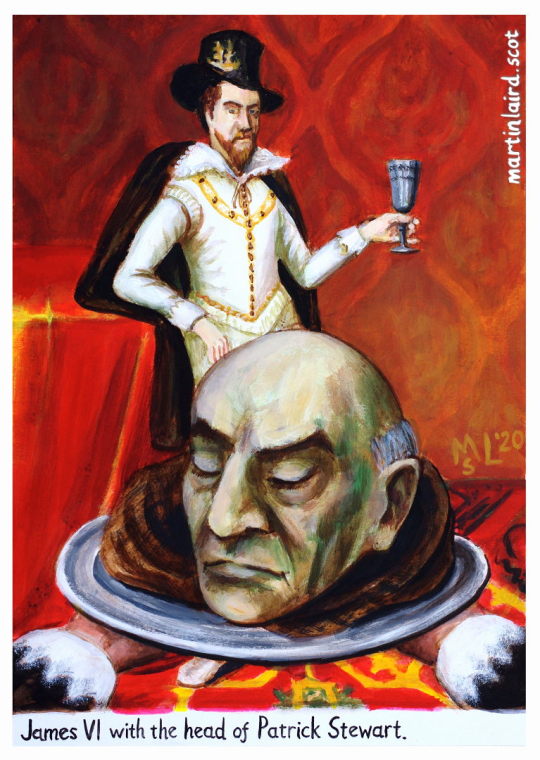
On February 6th 1615, Patrick Stewart, the tyrannical 2nd Earl of Orkney was beheaded in Edinburgh for treason.
As promised, a follow on from Sunday's post about Robert Stewart, an equally unpleasant member of the Stewar family that influenced Scotland so much.
Ultimately a footnote in the sweep of Scottish history, the earl was — and remains — locally infamous for his decadence and cruelty. He persecuted “witches” gleefully, one name : Alison Balfour, he accused of attempting to murder him. Stewart said that absent vigorous prosecution his subjects “wald all have becommit witches and warlockis for the people ar naturally inclynit thairto,” though the property forfeiture accompanying a witchcraft conviction might also have had something to do with it.
None of this had aught to do with the noble’s fall, although it was cited against him in passing; a treason charge for usurping royal authority arising from parochial jockeying for power did him in.
For those paying attention this basically follows up Friday’s post and sees the karma playing a part.
In 1593, the “iron grip” of the Stewart earls passed from Earl Robert to his second son, 28-year-old Patrick Stewart.
Like his father before him, Patrick’s rule over Orkney was not a particularly pleasant one, earning him the nickname “Black Patie”.
Patrick’s reputation for extravagance, arrogance and greed was matched only by his love of finery - exemplified in the magnificent Earl’s Palace in Kirkwall.
Stewart held the native Orcadians in very low regard. When not bickering with his own family, his time was spent feuding with the more powerful local families.
By 1606, Earl Patrick was heavily in debt and ignored a summons to appear before the Privy Council, in Edinburgh, to explain the complaints received regarding his extremely oppressive rule. He was even charged with treason but the charge was dropped in 1607, such was the power of The Stewarts.
The appointment of Bishop James Law, in the same year, marked the beginning of Patrick’s end. The bishop, a close friend and confidante of the Scottish king, James VI, presented a petition before the king, describing the oppression suffered by the people of Orkney. It is thought he also made mention of the danger the Stewart family posed - at this time the islands were still more Norse than Scottish. The latter statement probably prompted the King to take action.
In 1610, at the age of 35, Earl Patrick Stewart was indicted on seven charges of treason, on the ground of usurping royal authority. He remained in Edinburgh Castle, despite pleading justification for his actions on the islands’ County Laws.
While incarcerated, Patrick appointed his illegitimate son, Robert, as his deputy in Orkney. Robert had instructions to regain his father’s “houses” and to collect rents to prepare for his hoped-for restoration to the Earldom.
Robert’s attempt to comply with his fathers orders resulted in what amount to a rebellion against royal authority. Earl George Sinclair of Caithness - who had a score to settle with the Stewarts - came to the King’s aid, volunteering to lead and pay for an expedition to Orkney to quash Robert Stewart’s rebellion.
After a long siege of the Kirkwall Castle, the Bishop’s Palace and St Magnus Cathedral - where supporters were garrisoned - the Stewart rebellion was brought to its knees by the work of a traitor working from the inside.
Earl George threatened to demolish St Magnus’ Cathedral as a reprisal against the Orcadians who had nearly ruined him but fortunately Bishop Law persuaded him otherwise.
Patrick Stewart, the man destined to become Orkney’s most despised earl, was found guilty of treason in 1615, and subsequently beheaded. And according to tradition, so wicked was he that his execution had to be delayed for several days to give him time to learn the Lord’s Prayer.
As I touched upon earlier the accusation of witchcraft had become a particularly convenient way of depriving people of their land - in the following century there were many trials, often beginning in St Magnus Cathedral and ending at the stake.
And so the tyrannical Stewart’s reign ended in the northern isles. The picture shows Coat of arms of Earl Patrick. The first and fourth quarters show the Scottish royal arms debruised by a ribbon, a symbol of bastardy, while the second and third quarters show the arms of the Earldom of Orkney, you might recall from Monday’s post the Stewarts sprang from illegitimate children of King James the V. Other pic is The Earls Palace ruins at Kirkwall.
Such was their prowess at spreading their seed that recent DNA research shows that a remarkable round half of men with the Stuart or Stewart surname - regardless of the spelling - are believed to carry a unique marker in their Y chromosome which identifies them as the direct descendants of a 13th Century nobleman who fought alongside William Wallace and whose subsequent lineage includes the Stuart monarch, James VI of Scotland, so if you are a man and your surname’s Stewart/Stuart, around about half of you have royal lineage.
Pic is by Martin Laird https://martinlaird.scot/drawing-painting/james-vi-earl-patrick-stewart/
8 notes
·
View notes
Text
Book Review: Jelly Roll Blues: Censored Songs and Hidden Histories by Elijah Wald
Author: Elijah Wald
Title: Jelly Roll Blues: Censored Songs and Hidden Histories
Other Books Read By the Same Author:
Escaping the Delta: Robert Johnson and the Invention of the Blues
How the Beatles Destroyed Rock n Roll: An Alternative History of American Popular Music
Dylan Goes Electric!: Newport, Seeger, Dylan, and the Night That Split the Sixties
Publication Info: Hachette Books…

View On WordPress
2 notes
·
View notes
Text

Attorney Anita Faye Hill (July 30, 1956) is a lawyer and academic. She is a university professor of social policy, law, and women’s studies at Brandeis University and a faculty member of the university’s Heller School for Social Policy and Management. She became a national figure when she accused SCOTUS nominee Clarence Thomas, her supervisor at the US Department of Education and the EEOC, of sexual harassment.
She enrolled at Oklahoma State University and received a BA in psychology with honors. She went on to Yale Law School, obtaining her JD with honors.
She was admitted to the DC Bar and began her law career as an associate with the DC firm of Wald, Harkrader & Ross. She became an attorney-adviser to Clarence Thomas, who was the Assistant Secretary of the US Department of Education’s Office for Civil Rights. When Thomas became chairman of the US EEOC.
She then became an assistant professor at the Evangelical Christian O.W. Coburn School of Law at Oral Roberts University. She joined the faculty at the University of Oklahoma College of Law where she taught commercial law and contracts. #africanhistory365 #africanexcellence #zetaphibeta
1 note
·
View note
Photo

Mittsommerabend von Edward Robert Hughes(Undatiert, watercolour heightened with gouache on paper)
#artwork#art#kunst#kunstwerk#edward robert hughes#midsummer eve#mittsommerabend#fantasie#fantasy#magic#magie#mythical#woman#frau#fairytale#märchen#forest#wald#fairies#feen#folklore
24 notes
·
View notes
Text
May 2023 Birthdays | Monday, 05.01.2023
The upcoming birthdays for May 2023.
Monday, 5/8 - Caitlynn French | Chuck Huber
Thursday, 5/11 - David Wald | Tia Ballard
Friday, 5/12 - Robert Tinkler
Sunday, 5/14 - Alex Moore | Jessica Boone
Saturday, 5/20 - Ray Chase
Monday, 5/22 - Skyler Davenport
Thursday, 5/25 - J. Michael Tatum
Sunday, 5/28 - Laura Bailey | Liam O' Brien | Townsend Coleman
Monday, 5/29 - Erica Lindbeck
Tuesday, 5/30 - Mikaela Krantz
#monday monday#alex moore#caitlynn french#chuck huber#crunchyroll#david wald#english voice actors#erica lindbeck#funimation#j. michael tatum#jessica boone#laura bailey#liam o'brien#mikaela krantz#may 1#may 2023#monday motivation#ray chase#robert tinkler#sentai filmworks#skyler davenport#tia ballard#townsend coleman#upcoming#upcoming birthday#viz media#voice actors
1 note
·
View note
Text
one fact is that I am one of the people who at least tries to pronounce names from other languages correctly. one fact is that this causes hypercorrection of some American names. hence a conversation with my supervisor:
oh, like the construction in Robert /vald/'s book.
Who?
Bob /vald/. you know, the guy—
Who is that?
Bob /wɒld/. he—
Oh! Bob Wald! I didn't know he had a book on that.
11 notes
·
View notes
Photo
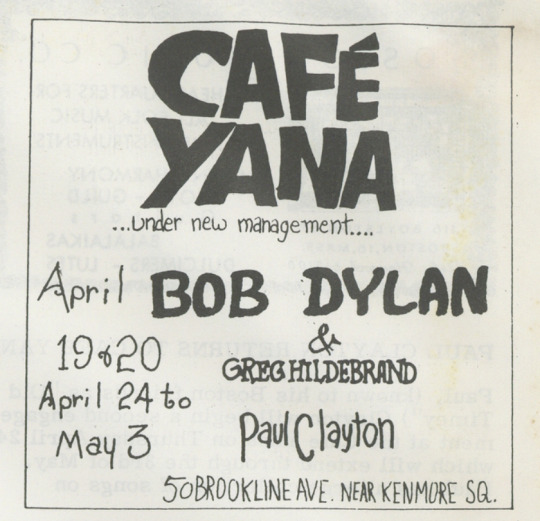
MORE BOB DYLAN IN BOSTON IN ‘63 MATERIAL PART ONE -->
Today it was my pleasure to share a story about an eventful weekend Bob Dylan had in Boston sixty years ago this week over in the Boston Globe. Thanks to everyone who read, shared, and sent along kind words. The Globe let me go loooooooong, and yet, there was still lots of interesting things we simply had to cut for space. Here’s some of the cut material, plus images and links we couldn’t include, too.
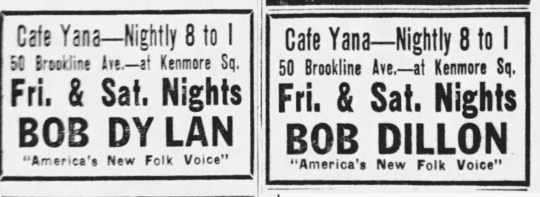
Why the name error? Likely just some residual confusion from the pre-Columbia Records era where Robert Zimmerman had indeed toyed with using both spellings of the soon-to-be-famous moniker.
A 1962 Michigan show also used this spelling. Thanks to author Elijah Wald for helping me make sense of this! Here's one opinion that thinks the 'Dillon' spelling was an homage to a Green Bay Packer. But Wald's guess is that this spelling was an homage to "Gunsmoke"‘s Matt Dillon.
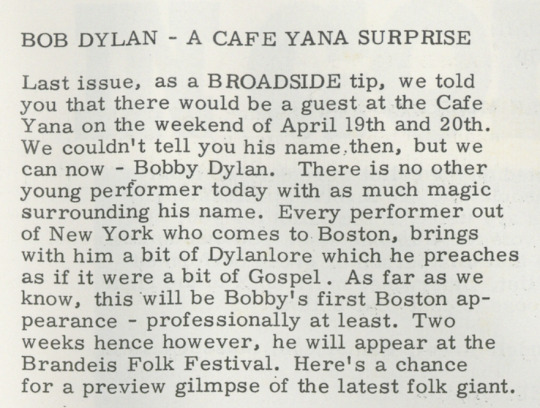
ABOVE: Broadside lets the cat out of the bag about the April 19 + 20 Dylan show. The Brandeis Folk Festival performance two weeks later became an official release in 2011.
Ok, so now for some weirdness that is sure to spark curiosity. The great David Wilson runs a wonderful Broadside group on Facebook. When I got going on the story, I searched for posts that mentioned Cafe Yana. I found David saying something curious in 2011:

So, I read this and get dizzy. Is there a full tape of one of the Yana performances? When asked today, Wilson believes he was confused about this earlier online assertion and that he must have been thinking of a different tape. Either way, when reached for comment, Geoff Muldaur stated, “I trust Dave’s memory, but I have no recollection. It was the Jug Band days and the party was on.” So, it’s a dead end, but sure to fuel some conjecture out there in Bob-world, for sure, yeah?
While his first LP only contained two originals, almost all of these new tracks were “Dylan compositions”—quotations are employed here to indicate that Freewheelin’ marks the blossoming of Bob Dylan’s extremely elastic interpretation of what it meant to be the ‘writer’ of a song, nicking old melodies here and lines of verse there, sometimes in alarming quantities, both from recordings and his folkie friends. In the big picture, this is simply how the folk process works, and in the organic, non-commercial world of the genre, for centuries, this is how it evolved and was sustained, and no one ever, er, thought twice about it. But as Dylan’s compositions started to turn into hits, and hits begat huge paychecks, many in the folk music scene began to look around and ask, “Wait, is this how it works?”
For instance, one song he learned from Von Schmidt in Boston, “Baby, Let Me Follow You Down,” was a highlight of Dylan’s debut album, but it also led to one of his first run-ins with questions of authorship where lawyers got involved. On the one hand, Dylan couldn’t be more clear about it, speaking over the introductory chords on the recording, “I first heard this from Rick von Schmidt...I met him one day in the Green pastures of Harvard University.” But when Dylan suggested to Rick that he should be getting some money from the sales of his album, Rick explained how he had based it on a song by Blind Boy Fuller titled “Mama Let Me Lay It on You.” Dylan’s legal representation responded that von Schmidt was correct, that he had no claim to the song, and then proceeded to copyright the composition entirely to Mr. Dylan.
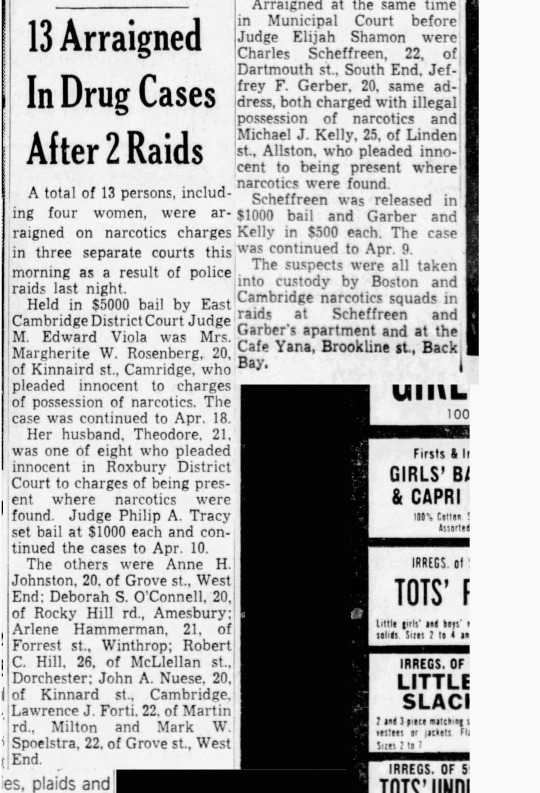
Just a few weeks before Dylan’s shows there, Café Yana had been raided by the Boston police narcotics squad, nabbing songwriter Mark Spoelstra (the witness to Bob and Kweskin’s song-off) along with some members of the audience for possession of marijuana. Poor guy, he had just moved here!
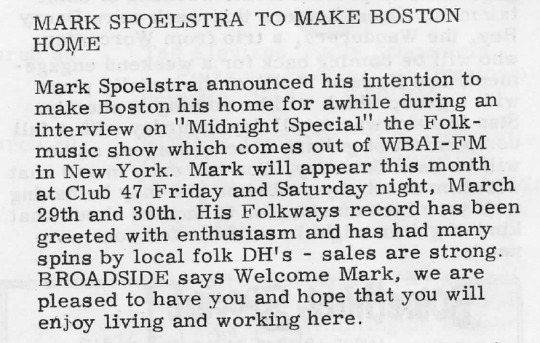
SCENE SETTING: Friday April 19th, 1963 was Patriot’s Day in Boston and Paul Revere’s infamous freedom ride was reenacted by Lt. Ben White. Belgian athlete Aurele Van Den Driessche had not only taken first place in the Boston Marathon, he also set a new record. At Fenway Park, the Red Sox bested the Detroit Tigers in both games of their heated double header. Over at Boston College, preparations were being made for President Kennedy to observe the college’s 100th year with some remarks to occur the following day. It was mere weeks after The Boston Strangler’s latest victim, seventeen days before his next, and the $5000 reward for his capture wasn’t resulting in any new leads. Meanwhile, across the Charles River in Cambridge, professors Timothy Leary and Richard Alpert awaited news of their professional fate after controversy arose around their experimental decision to give Harvard graduate students mind-altering substances including Lysergic acid diethylamide (LSD) and psilocybin in pursuit of the secrets of human potential.
Below, Bob reads about himself in the Oct 30 ‘63 Broadside of Boston issue backstage at Jordan Hall on 11/2/63.
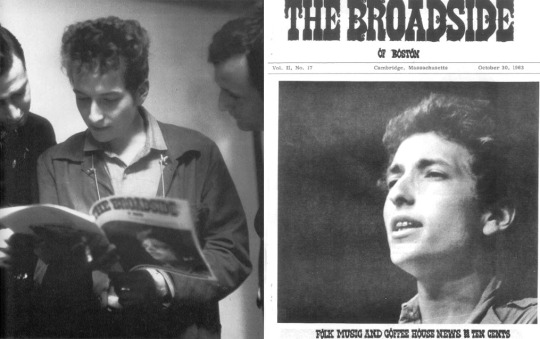
Fast forward to 1965: Dylan is back in Boston to perform with a full electric band at Back Bay Theater at 209 Massachusetts Ave. David Wilson told me that earlier that day, before the show, Dylan and Bob Neuwirth showed up at the Broadside office and proceeded to just devour all back issues of Broadside, reading as many as they could, making comments to each other about this and that. They were there for hours; Wilson had some nice conversation with Neuwirth, but barely a word with bookworm-Bobby. At the end of the afternoon, BD asked Wilson if he was coming to the concert. Wilson said he had given the newspaper’s comp tickets to a writer who would cover it. Dylan said he wanted Wilson to come too and could leave tickets for him at the door. Wilson politely demurred saying, “Well I’m sure it’s completely sold out by now.” Dylan again insisted that Wilson should come see it. Finally, he agreed, “yes, please leave me tickets and I’ll be there.” Dylan, now satisfied, departed. Later that night, Wilson showed up at Back Bay Theatre only to find no tickets were under his name at the door.
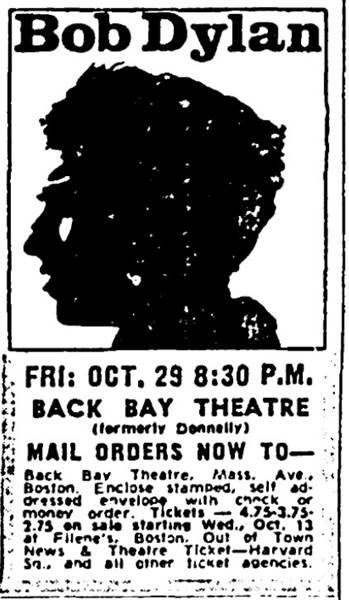
Part II is here.
5 notes
·
View notes